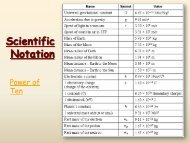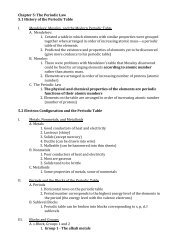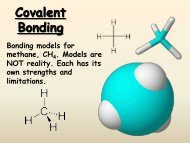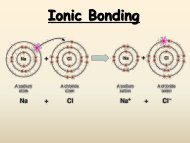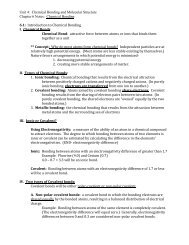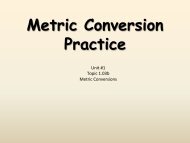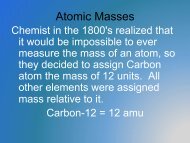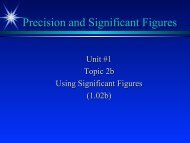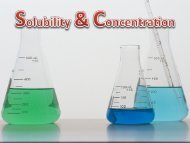HISTORY OF THE DEVELOPMENT OF THE ATOMIC MODEL
HISTORY OF THE DEVELOPMENT OF THE ATOMIC MODEL
HISTORY OF THE DEVELOPMENT OF THE ATOMIC MODEL
- No tags were found...
Create successful ePaper yourself
Turn your PDF publications into a flip-book with our unique Google optimized e-Paper software.
Greeks to Quantum Mechanics <br />
<strong>HISTORY</strong> <strong>OF</strong> <strong>THE</strong> <strong>DEVELOPMENT</strong> <br />
<strong>OF</strong> <strong>THE</strong> <strong>ATOMIC</strong> <strong>MODEL</strong> <br />
http://www.teachersdomain.org/asset/phy03_vid_atoms/
The Greeks <br />
History of the Atom <br />
§ Not the history of atom, but <br />
the idea of the atom <br />
§ In 400 B.C the Greeks tried to <br />
understand matter (chemicals) <br />
and broke them down into <br />
earth, wind, fire, and air. <br />
<br />
Fire Water Earth Air
Fire Water Earth Air
Greek Model <br />
Democritus <br />
§ Greek philosopher <br />
§ Idea of atomos <br />
ú Atomos = indivisible <br />
ú Atom is derived <br />
To understand the very large, <br />
we must understand the very small. <br />
§ No experiments to support idea <br />
Democritus 400 B.C. <br />
Democrituss model of atom <br />
No protons, electrons, or neutrons <br />
Solid and INDESTRUCTABLE
Alchemy <br />
§ After that chemistry was <br />
ruled by alchemy. <br />
§ They believed that they <br />
could take any cheap metals <br />
and turn them into gold. <br />
§ Alchemists were almost like <br />
magicians. <br />
ú elixirs, physical immortality
Alchemy <br />
Alchemical symbols for substances… <br />
.<br />
.<br />
.<br />
<br />
<br />
.<br />
.<br />
<br />
.<br />
.<br />
<br />
<br />
<br />
.<br />
. .<br />
<br />
<br />
.<br />
.<br />
.<br />
GOLD SILVER COPPER IRON SAND<br />
transmutation: changing one substance into another <br />
Δ <br />
In ordinary chemistry, we cannot transmute elements.
Contributions <br />
of alchemists: <br />
Information about elements <br />
-‐ the elements mercury, sulfur, and antimony were discovered <br />
-‐ properties of some elements <br />
Develop lab apparatus / procedures / experimental techniques <br />
-‐ alchemists learned how to prepare acids. <br />
-‐ developed several alloys <br />
-‐ new glassware
Early Ideas on Elements <br />
Robert Boyle stated... <br />
ú A substance was an <br />
element unless it could be <br />
broken down to two or <br />
more simpler substances. <br />
ú Air therefore could not be <br />
an element because it <br />
could be broken down in <br />
to many pure substances. <br />
Robert Boyle
Modern Chemistry <br />
• Beginnings of modern chemistry were seen in the sixteenth <br />
and seventeenth centuries, where great advances were made <br />
in metallurgy, the extraction of metals from ores. <br />
• In the seventeenth century, Boyle described the relationship <br />
between the pressure and volume of air and defined an <br />
element as a substance that cannot be broken down into two <br />
or more simpler substances by chemical means. <br />
Copyright © 2007 Pearson Benjamin Cummings. All rights reserved.
Modern Chemistry <br />
• During the eighteenth century, Joseph Priestley <br />
discovered oxygen gas and the process of <br />
combustion where carbon-‐containing materials <br />
burn vigorously in an oxygen atmosphere. <br />
• In the late eighteenth century, Lavoisier discovered <br />
respiration and wrote the first modern chemistry <br />
text. His most important contribution was the <br />
law of conservation of mass, which states <br />
that in any chemical reaction, the mass of <br />
the substances that react equals the mass <br />
of the products that are formed. He is known <br />
as the father of modern chemistry. <br />
Lavoisier <br />
Priestley <br />
Copyright © 2007 Pearson Benjamin Cummings. All rights reserved.
• The transformation of a substance <br />
or substances into one or more new <br />
substances is known as a chemical <br />
reaction. <br />
• Law of conservation of mass: <br />
mass is neither created nor <br />
destroyed during ordinary chemical <br />
reactions or physical changes <br />
total mass of the products = total mass of the reactants
LAW <strong>OF</strong> CONSERVATION <strong>OF</strong> MASS
• Law of definite proportions: a <br />
chemical compound contains the <br />
same elements in exactly the same <br />
proportions by mass regardless of <br />
the size of the sample or source of <br />
the compound-‐ Joseph Proust 1799
Law of Definite Proportions con’t <br />
Example: <br />
• all samples of water (H 2 O) contain a ratio <br />
of 8 g oxygen to 1 g hydrogen <br />
• all samples of iron sulfide (FeS) contain a <br />
ratio of 7 g iron to 4 g sulfur <br />
• If 4 g of element A combine with 20 g of <br />
element B, how many grams of element A <br />
would react with 50 g of element B
• Law of multiple proportions: if two <br />
or more different compounds are <br />
composed of the same two elements, <br />
then the ratio of the masses of the <br />
second element combined with a <br />
certain mass of the first element is <br />
always a ratio of small whole <br />
numbers-‐ John Dalton1803
Law of Multiple Proportions-‐ con’t <br />
Example: <br />
2 compounds of hydrogen and oxygen: <br />
H 2 O and H 2 O 2 <br />
H 2 O 8 g oxygen : 1 g hydrogen <br />
H 2 O 2 16 g oxygen : 1 g hydrogen
DALTON’S <strong>ATOMIC</strong> <strong>THE</strong>ORY <br />
• All matter is composed of extremely <br />
small particles called atoms. <br />
• Atoms of a given element are identical <br />
in size, mass, and other properties; <br />
atoms of different elements differ <br />
in size, mass, and other properties. <br />
• Atoms cannot be divided, created, <br />
or destroyed
DALTON’S <strong>ATOMIC</strong> <strong>THE</strong>ORY, <br />
CONTINUED <br />
• Atoms of different elements <br />
combine in simple whole-‐number <br />
ratios to form chemical <br />
compounds. <br />
• In chemical reactions, atoms are <br />
combined, separated, or <br />
rearranged.
John Dalton(1766-‐1844)
MODERN <strong>ATOMIC</strong> <strong>THE</strong>ORY <br />
• Not all aspects of Daltons atomic theory have proven to be correct. <br />
We now know that: <br />
• Atoms are divisible into even smaller particles.<br />
• A given element can have atoms with different<br />
masses.<br />
• Some important concepts remain unchanged.<br />
• All matter is composed of atoms.<br />
• Atoms of any one element differ in properties from atoms<br />
of another element.
1 st Model of the Atom<br />
Billiard Ball Model
Benjamin Franklin <br />
§ American scientist, politician, inventor <br />
§ 1706-‐1790 <br />
§ Flew kite -‐ 2 kinds of electrical charge <br />
§ Named + positive, -‐ negative
Michael Faraday <br />
§ English chemist <br />
§ 1791-‐1867 <br />
§ 1839 suggested atom structure related to <br />
electricity
DISCOVERY <strong>OF</strong> <strong>THE</strong> ELECTRON <br />
• Experiments in the late <br />
1800s showed that cathode <br />
rays were composed of <br />
negatively charged particles. <br />
J.J.Thomson(1856-‐1940)<br />
These particles were named<br />
electrons
** William Crookes <br />
(1870s): <br />
Rays causing <br />
shadow were <br />
emi>ed from <br />
cathode. <br />
Maltese cross CRT <br />
radar screen <br />
television <br />
computer <br />
monitor
q The Thomsons (~1900) <br />
J.J. Thomson discovered <br />
that cathode rays are… <br />
…deflected by electric <br />
and magneJc fields <br />
electric field lines <br />
cathode rays <br />
+ + + + + + <br />
J.J. Thomson <br />
Crookes tube <br />
… (–) parJcles <br />
– – – – – – <br />
electrons <br />
phosphorescent <br />
screen
2 nd Model of the Atom <br />
§ Thomson <br />
introduced his <br />
model in 1904 <br />
§ a sphere of <br />
positive charge <br />
with e-‐ embedded <br />
in it called <br />
Plum Pudding <br />
Model
• Robert A. Millikans oil drop <br />
experiment measured the <br />
charge of an electron.
Henri Becquerel <br />
§ French physicist <br />
§ 1852-‐1908 <br />
§ 1896 discovered radioactivity
DISCOVERY <strong>OF</strong> <strong>THE</strong> <br />
<strong>ATOMIC</strong> NUCLEUS <br />
Ernest Rutherford <br />
• More detail of the atoms structure was provided in <br />
1911 by Ernest Rutherford and his associates Hans <br />
Geiger and Ernest Marsden. <br />
• The results of their gold foil experiment led to the <br />
discovery of a very densely packed bundle of matter <br />
with a positive electric charge. <br />
• Rutherford called this positive bundle of matter the <br />
nucleus.
Gold Foil Experiment<br />
gold foil<br />
beam of alpha particles<br />
radioactive<br />
substance<br />
fluorescent screen<br />
circular - ZnS coated
q Ernest Rutherford (1909) <br />
q Gold Leaf Experiment <br />
Beam of α-‐parJcles (+) directed at <br />
gold leaf surrounded by <br />
phosphorescent (ZnS) screen. <br />
α-‐source <br />
parJcle <br />
beam <br />
gold <br />
leaf <br />
lead <br />
block <br />
ZnS <br />
screen
History of Atomic Theory <br />
§ Rutherford with his assistant W.H. Geiger
History of Atomic Theory <br />
§ Rutherford theorized that if the <br />
Plum Pudding model was correct. <br />
The number of positive and <br />
negative particles in an atom <br />
would be the same with the <br />
particles evenly spread within the <br />
atom
History of Atomic Theory <br />
QuickTime and a<br />
Graphics decompressor<br />
are needed to see this picture.
History of Atomic Theory <br />
§ the result was completely <br />
unexpected by Rutherford and his <br />
assistant Geiger <br />
§ Rutherford was forced to rethink <br />
the model realizing that the only <br />
explanation was that all the <br />
positive particles must have been <br />
together in a nucleus
3 rd Model of the Atom <br />
The Rutherford Model <br />
-‐ <br />
-‐ <br />
-‐ <br />
-‐ <br />
-‐ <br />
-‐ <br />
-‐ <br />
-‐
3 rd Model of the Atom <br />
§ Ernest Rutherford <br />
§ Rutherford Model <br />
§ Developed 1908 with the <br />
discovery of the proton <br />
§ Positive nucleus surrounded <br />
by negative electrons
History of Atomic Theory <br />
§ A few years later, experiments <br />
were conducted indicating that <br />
Rutherford's model had some <br />
problems, namely that it did not <br />
explain why the electrons would <br />
not crash into the nucleus when it <br />
inevitably lost energy
Henry Moseley <br />
§ British chemist and physicist <br />
§ 1887-‐1915 <br />
§ Thru table each more positive than last <br />
§ Individual positive charge -‐ “proton” <br />
§ The number of protons -‐ atomic number
Niels Bohr <br />
§ Danish Physicist, <br />
Niels Bohr(1913), <br />
solved the problem <br />
by adding to the <br />
Rutherford Model <br />
his idea of relatively <br />
fixed orbits-‐<br />
Planetary Model
The Bohr Model <br />
§ electrons traveled in orbits around <br />
the nucleus <br />
§ each e-‐ has a minimum amount of <br />
energy that will keep it in its <br />
lowest orbit and not allow it to <br />
crash into the nucleus(Ground <br />
State)
4 th Model of the Atom <br />
Bohr’s Model (Planetary Model)
4 th Model of the Atom <br />
§ Developed by Niels Bohr <br />
§ Called the Planetary Model or <br />
Bohr Model <br />
§ Introduced in 1913 <br />
§ Positive nucleus with electrons <br />
traveling in orbits
James Chadwick <br />
§ British physicist -‐ 1935 Nobel Physics <br />
§ 1891-‐1974 <br />
§ 1932 discovered existence of “neutrons” <br />
§ uncharged -‐ slightly heavier than protons <br />
§ found in nucleus
Quantum Mechanics Model
5th Model of the Atom <br />
§ Developed by many scientists (Schroedinger & <br />
Heisenburg) <br />
§ Quantum Mechanics Model <br />
§ Introduced in the 1930s and 1940s <br />
§ Mathematical model – positive nucleus with a <br />
fuzzy cloud of electrons
q Thomsons Daltons q Rutherfords (also Plum Pudding Greek) Model Model <br />
–<br />
<br />
– <br />
– <br />
– <br />
–<br />
<br />
–<br />
<br />
–<br />
<br />
+ <br />
– <br />
+ <br />
+ + <br />
– <br />
– <br />
– <br />
+ + <br />
– <br />
+<br />
N<br />
<br />
+ <br />
– – <br />
+ + – <br />
–<br />
<br />
+ <br />
–
Bohr Model
Quantum Mechanics Model
To Be Continued… <br />
§<br />
http://www.teachersdomain.org/asset/phy03_vid_quantum/
Review of the Atomic Models <br />
Draw all the Atomic Models <br />
through history and name the <br />
scientist who is responsible for <br />
that model. <br />
http://www.teachersdomain.org/asset/<br />
phy03_vid_uncertainty/






